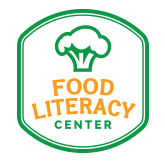October is National Farm to School Month!
What’s For Lunch? More Schools Adding Local Food to Menu, Curriculum
National Farm to School Network Coordinates Celebration of Second Annual National Farm to School Month in October
CHICAGO, September 17, 2012 – As students settle into the new school year, they’re finding more local food on their lunch trays, more nutrition and agriculture-related topics in their curriculum and more gardens in the schoolyard thanks, in part, to the “Farm to School” movement.
The U.S. will observe the second annual National Farm to School Month this October, but the Farm to School movement dates back to the early ’90s, when only a handful of Farm to School programs existed. Today, over 12,500 schools in all 50 states participate in some form of Farm to School activity, according to Anupama Joshi, Executive Director of the National Farm to School Network (NFSN).
“The newest growth area for Farm to School programs involves ‘Farm to Preschool’ for children up to the age of 6,” Joshi said. “Over 160,000 children enrolled in Head Start, nurseries and family home care are already enjoying local foods and learning about where their food comes from.”
Farm to School Programs Are Sprouting Up Everywhere
The “Farm to School” movement seeks to improve student nutrition,
support small farms and local economies, and help children
understand where their food comes from. School food service
directors, teachers, farmers, parents, students and advocates are
banding together to increase the presence of healthy, local foods
in school lunchrooms and lesson plans.
“Farm to School programs are sprouting up everywhere because people understand that children are much more likely to enjoy eating broccoli or zucchini when they help plant it in a school garden,” Joshi said. “In addition to helping improve school food and combat childhood obesity, Farm to School programs support local farmers and strengthen local and regional economies.”
Farm to School is getting a boost this year from the new USDA nutrition guidelines for school meal programs. Beginning this school year, the nearly 32 million children who participate in school meal programs will be served nearly twice the previous amount of fruits and vegetables each day. While schools operating Child Nutrition programs are not required to purchase locally grown and locally raised foods, they are allowed to use geographic preferences in the procurement bidding process for school meal programs.
Showing How “Farm to School Counts”
Congress approved a resolution officially designating October as
National Farm to School Month in November 2010. Schools will
celebrate National Farm to School Month in a variety of ways.
Many will take advantage of the harvest season to prepare the
last of the locally grown tomatoes. Some will schedule visits to
farms or bring farmers or chefs into the classroom. Others will
take advantage of PTA meetings to serve parents samples of the
foods that their children are eating during the day.
The National Farm to School Network is encouraging schools to celebrate Farm to School Month by participating in “Farm to School Counts,” a promotion designed to demonstrate the sheer volume of Farm to School activity taking place across the country in October. Using a simple form on the National Farm to School Month website, www.farmtoschoolmonth.org, schools will pledge to participate in Farm to School during October and estimate the dollar value of local foods they plan to serve or the number of students who will participate in related educational activities. The total number of local foods served and activities held will be reported in November.
In addition, each weekday in October will have a theme that celebrates one aspect of Farm to School programs or specific foods. The National Farm to School Month website will feature recipes, educational activities, and fun facts that programs can incorporate into their Farm to School Month celebrations.
About The National Farm to School Network
The National Farm to School Network is a network of national staff, state and regional leads and thousands of Farm to School practitioners, advocates and community leaders working to make Farm to School programs an essential component of strong and just local and regional food systems, and ensuring the health of all school children, farms, the environment, economy and communities. NFSN is a project of The Tides Center.

